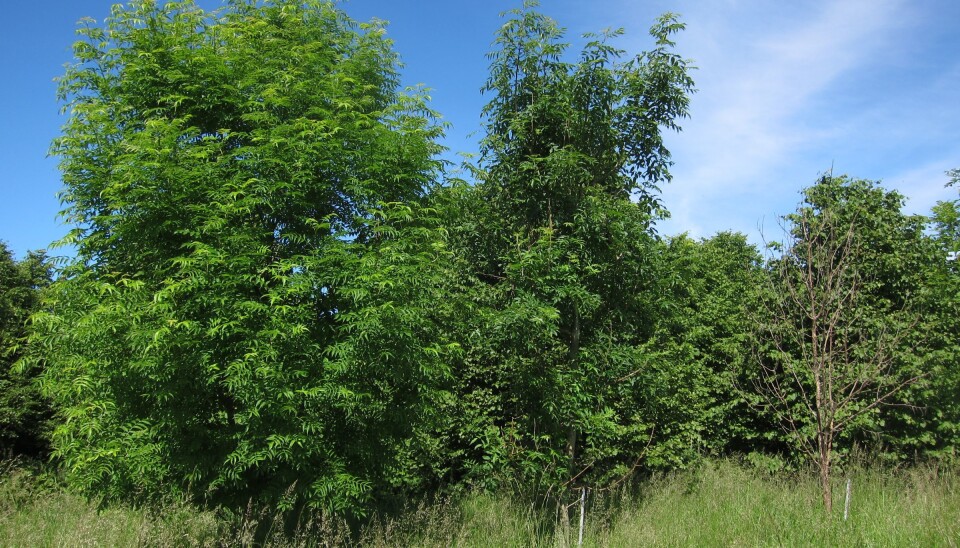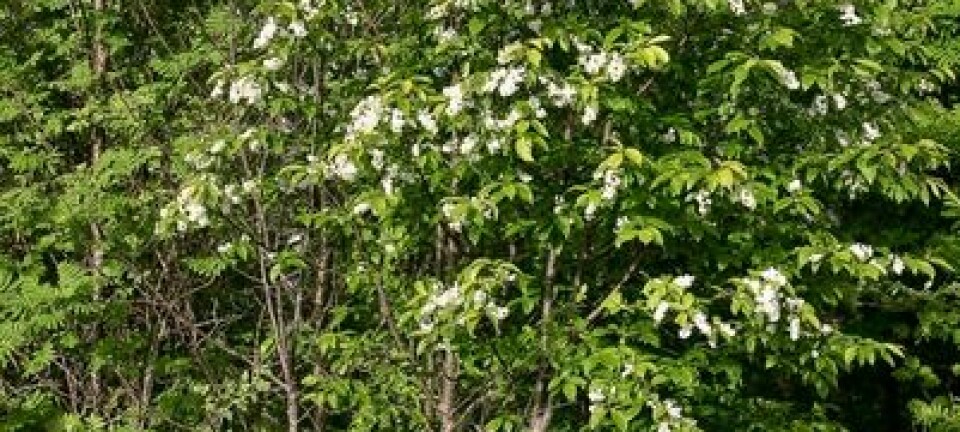
Surviving ash trees help to address evolutionary riddle
A pathogenic fungus is killing thousands of European ash trees every year. Danish researchers are now trying to uncover the genetics behind the unknown defence mechanism in ash trees. Not only to save the ash trees, but also to address an evolutionary mystery in trees.
Since 2003, the aggressive Hymenoscyphus pseudoalbidus fungus has infected just about all Danish ash trees with the fungal disease ash dieback. The situation is the same across most of Europe.
One by one the trees become infected with the disease, which is characterised by leaf loss and crown dieback.
Only 2-3 percent of the ash trees appear to have a defence mechanism which enables them to withstand the fungus.
A research group from the University of Copenhagen is currently working intensely to figure out how these few ash trees manage to evade the disease, an ability that may be used to rescue the entire ash tree population.
We’re currently on the lookout for healthy trees that can resist the fungus. These trees will be used to create a large collection of trees that can form the basis of the future ash population.
“Common Ash is a keystone species in Danish countryside, and it would be terrible if the trees were to disappear from areas like ash marshes, where they contribute to maintaining the biodiversity. The ash trees also have a great commercial value to forest owners,” says Lene Rostgaard Nielsen, a senior researcher at the Department of Geosciences and Natural Resource Management at the University of Copenhagen.
”Trees that would otherwise have been used to make fancy furniture or wooden floors instead end up as firewood or simply as dead trees in the forests as a consequence of this disease. So there are plenty of good reasons for us to try and find a way of helping the ash stands.”
Research focuses on healthy trees
In their project, the researchers are primarily examining the few trees that fought the fungus and survived the disease.
At this early stage in the project, they have discovered that the ability to resist the fungus is genetically determined and can be inherited from one generation to the next.
If we can identify some genetic markers for resistance in ash trees, we can develop a genetic tool to quickly determine which ash trees can defend themselves against infection. Such a tool could give our British colleagues a quick indication of which trees are suitable for restocking and planting in areas infected by the ash fungus.
This allows for replanting of resistant ash trees in areas where the fungus has displaced the original ash trees.
To make this possible, the team is working to identify the resistant trees that can form the basis of the rescue of the species as a whole.
”We’re currently on the lookout for healthy trees that can resist the fungus,” says Nielsen. “These trees will be used to create a large collection of trees that can form the basis of the future ash population.”
Genetic research can identify resistant trees
The researchers are also trying to genetically sequence a variety of infected and healthy ash trees to identify differences in the genomes.
It is very interesting that the trees manage to keep the harmful fungi at bay, despite having to fight against a much faster evolution. We do not yet fully understand exactly how the trees can do this, but with an enhanced understanding of the genetics behind the ability of some ash trees to defend against ash dieback, we will also come closer to a general understanding of the defence mechanisms that these trees use.
They will study the number and nature of the genes that are involved in the defence mechanism of the healthy trees.
This knowledge can e.g. be used to create genetic tools that will determine whether or not certain uninfected trees are at risk of becoming diseased.
“We would like to help our European colleagues to find out which of their ash trees are at risk. Ash dieback has, for instance, just arrived in the UK, so our British colleagues turn to us for our expertise,” says the researcher.
”If we can identify some genetic markers for resistance in ash trees, we can develop a genetic tool to quickly determine which ash trees can defend themselves against infection. This could give our British colleagues a swift indication of which trees are suitable for future restocking of forests with ash trees.”
This may well turn out to be an invaluable tool in the future, where we will be seeing many new tree diseases spreading around the globe as invasive species either as a result of displacement or climate change.
Such a genetic tool would also play an important role in identifying healthy trees in Denmark that form a basis for the forests of the future. With trees, everything takes time, and a DNA test would be much quicker and more efficient than testing the resistance of the trees in field trials.
Study also addresses an evolutionary riddle
If the researchers manage to reveal why some of the Danish ash trees manage to resist an ash dieback fungus, they would also come one step closer to understanding some of the evolutionary mysteries regarding the immune system in trees in general.
It is a mystery how trees generally can keep up with the evolution of pathogenic fungi, which have generation times that are much shorter than their own.
Rapid mutation in fungi continuously creates new variants that trees may have difficulties in recognising as pests. The trees could seem defenceless due to their much longer generation times.
A greater general understanding of defence mechanisms
Nevertheless, the trees often have a response to new diseases that in some cases they have never encountered before. They must therefore rely on a defence mechanism that is not based on recognition of the specific fungal species::
”It is very interesting that the trees manage to keep the harmful fungi at bay, despite their much faster evolution. We do not yet fully understand exactly how the trees can do this, but with an enhanced understanding of the genetics behind the ability of some ash trees to defend themselves against ash dieback, we will also come closer to a general understanding of the defence mechanisms that these trees use,” says Nielsen.
”This may well turn out to be an invaluable tool in the future, where we will be seeing many new tree diseases spreading around the globe as invasive species either as a result of displacement or climate change.”
------------------------
Read the Danish version of this article at videnskab.dk









